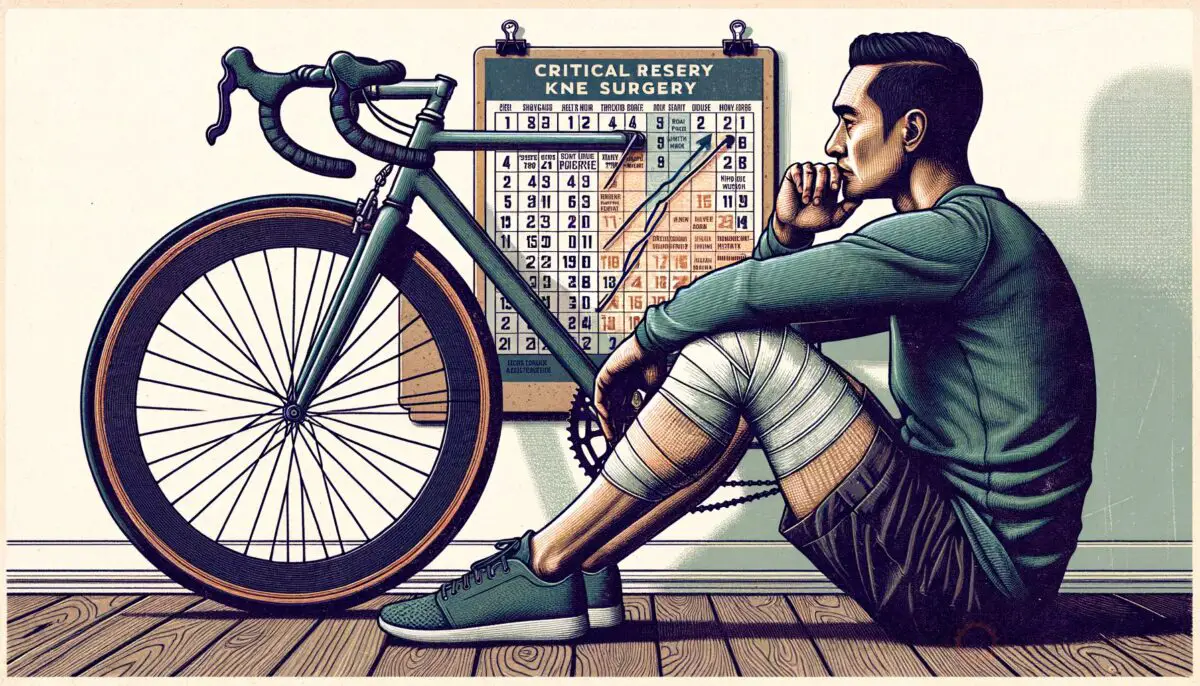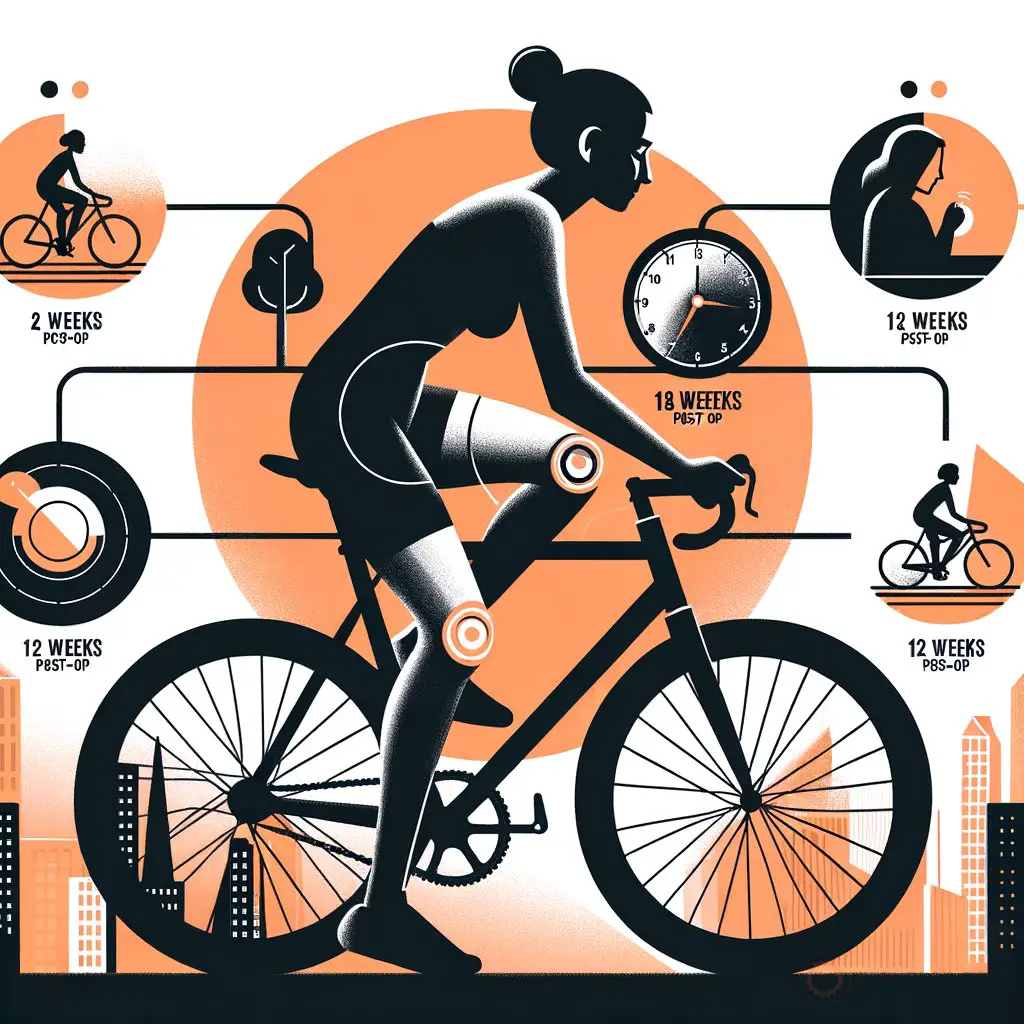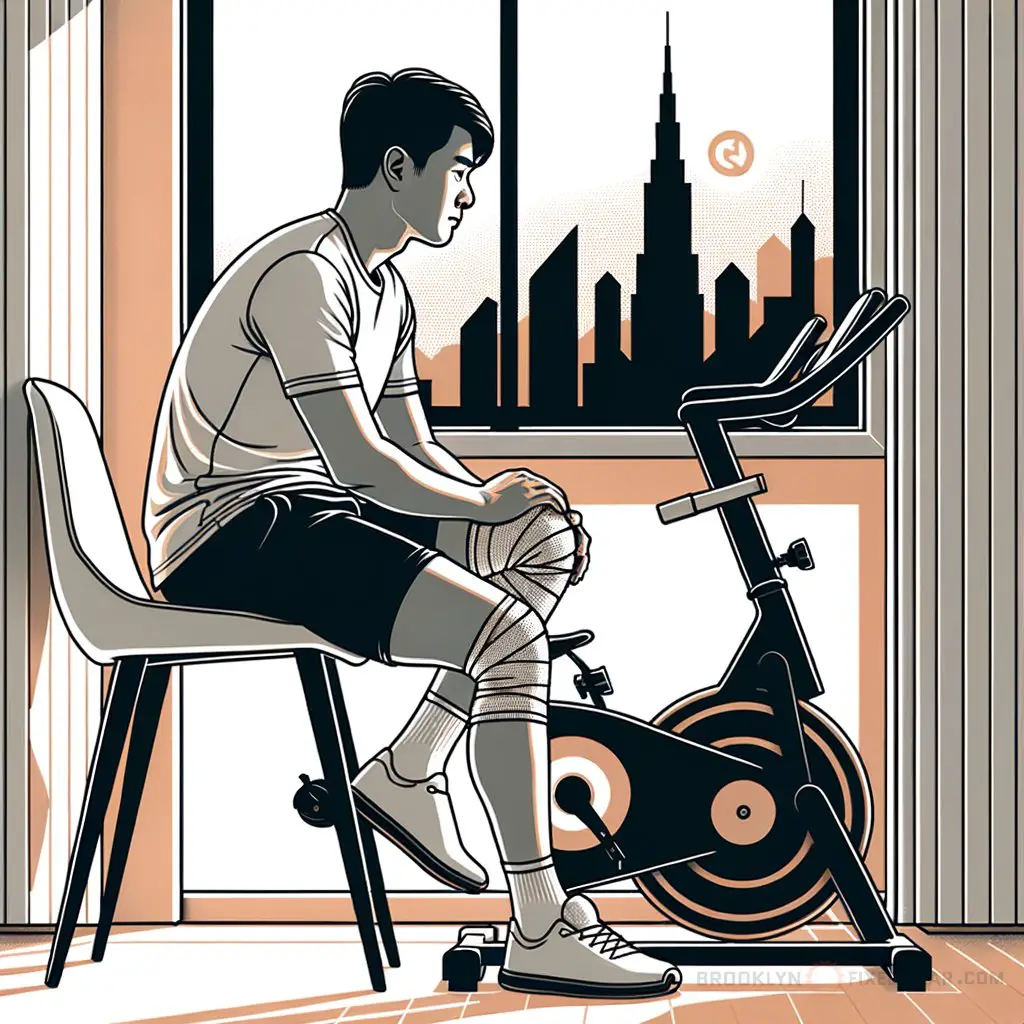Ever felt the rush of zipping through the cityscape on a slick fixie, pushing the limits with each pedal stroke? Imagine that being put on pause because your knee called it quits.
When can you reignite that passion and cycle after knee surgery? That’s the million-dollar question buzzing in your head as you count down the days to your big comeback. In this post, we’ll unveil the pivotal steps and timelines for your return to the saddle.
Key takeaways
- Start stationary cycling within two weeks post-surgery, gradually building strength and motion.
- Transition to road cycling after about 12 weeks, with the go-ahead from your physio.
- Listen to your body and adjust—sharp pains are a stop sign, while mild discomfort can be part of the road back.
How soon can you start cycling after knee surgery?
Cycling is not just a sport; it’s a way of life, especially for those who love their fixies as much as I do. But when a knee surgery sidelines you, knowing when it’s safe to get back on the track is critical. The timeline for your pedal-pumping comeback hinges on the type of surgery—be it a total knee replacement, partial, or arthroscopy.

Rest assured, cycling is usually endorsed by doctors as part of your recovery repertoire.
Despite the eagerness to resume cycling, your new knee needs tender loving care and time to heal. Typically, a static bike becomes your best buddy about two weeks post-op. Don’t fret; the outdoor adventures await, usually around the 12-week mark.
These phases are all about fortifying your knee, granting you a free pass to regain your street cred and capture that sense of freedom once more.
Here’s a quick rundown on why a fixie enthusiast like you should circle these timelines on your calendar:
- Stationary cycling within two weeks: A controlled environment helps in restoring motion without overloading your new joint.
- Road cycling at 12 weeks: Gives your knee time to heal and adapt, reducing the risk of reinjury.
- Pedal pacing: Start slow to allow gradual adaptation, and avoid the torment of a premature full-throttle comeback.
- Clear benchmarks: Knowing approximate recovery stages manages your expectations and sparks motivation.
State Bicycle Co. Black Label 6061

State Bicycle Co. Black Label 6061
Recovery and cycling post knee surgery
Recovery from knee surgery is a journey that varies from patient to patient, with the goal of returning to normal activities safely. For cyclists, especially fixed-gear aficionados, hopping back onto a bike is a priority. Generally, rehabilitation focuses on reducing knee swelling and restoring full range of motion.
“Embrace each step, no matter how small it seems. Simple activities such as short walks or stair climbing serve dual roles—as rehab for your knee and as primers for muscles long associated with cycling success.”
Stationary cycling starts making an appearance in the recovery plan one to two weeks after surgery. Here, the bike acts as a controlled, low-impact workout tool, facilitating safe movement of the knee joint without bearing full body weight. After about 12 weeks, depending on individual progress, the pedals of an outdoor bike call for your return.
Transition to road cycling
After initial weeks spent bonding with a stationary bike, the transition to road cycling marks a significant milestone in recuperation. This crucial phase usually occurs up to 12 weeks post-operation. It’s essential to start with short rides, paying close attention to pain as a guide for progression.

Patient’s comfort and safety are paramount, so ensure your bike saddle and handlebars are adjusted for optimal riding posture. Consult a professional for a bike fitting to minimize straining your new knee. If discomfort or sharp pain present during any cycling activity, it’s time to hit the brakes and check in with your physiotherapist.
Mountain biking considerations
Fixed-gear riders might not usually dabble in mountain biking, but should you be tempted, approach this variant cautiously after knee surgery. Typically, mountain biking is permissible around the same 12-week mark as road cycling, but this is where the terrain’s unpredictability ups the stakes.
The rocky paths and unexpected obstructions mean the risk of falls, and thus, impacts on your knee, is greater. This doesn’t rule out off-road antics completely, but it does call for extra caution and perhaps further consultation with your physician if your heart’s set on it.
Gradual buildup in cycling intensity
Diving back into cycling with the same intensity as pre-surgery is a recipe for disaster. The key is gradual buildup, not just in distance but also in resistance. As you bolster the muscles around your knee, remember to notch up the difficulty slowly to ensure your new joint can keep up with the enthusiasm without caving under pressure.
Discuss with your physiotherapist the appropriate resistance levels for your stationary bike sessions. This will help graduate to more challenging outdoor cycling over time without harming your knee. Watch for any discomfort during the process, as this will inform any necessary adjustments to your routine.
Guidelines for cycling after partial knee replacement
The directives following a partial knee replacement generally echo those set for total knee replacement—with one distinct difference in timelines. You may find that you’re able to mount your fixie after only 8 weeks, depending on how you handle the rehab sessions and your body’s response to the surgery.
Still, the same principles of caution and structured progression apply. Over-exuberance is a potential enemy; conversely, a measured and realistic approach becomes your most steadfast ally throughout the healing procedure.
Aftercare and exercises post-surgery
Early days post-surgery usually present the most challenges and restrictions. Your physiotherapy will likely kickstart with exercises that bolster your quads, hips, and glutes. Embrace each step, no matter how small it seems.
Even simple activities such as short walks or stair climbing can have substantial benefits. They serve dual roles—as rehab for your knee and as a primer for muscles that have long contributed to cycling success.
Walking releases the shackles bit by bit, helping you gain strength and stability in your knee. With daily progress, relying on crutches or a walker will become a mere memory, paving the way for freewheeling days ahead.
Cycling’s role in the recovery process
Cycling isn’t just a hobby for most—it’s therapeutic. After knee surgery, it becomes part of the healing process, both physically and emotionally. Not only does it foster physical therapy, but it also reignites the flames of passion that might have dimmed post-op.
The stationary bike becomes a therapeutic agent almost immediately. Very few other rehab exercises can match its effectiveness in marrying knee flexibility and muscle toning, with little risk of overstressing the joint.
Cycling after knee replacement can be both a goal and a reward—a physical activity that offers both the means to an end and a source of enjoyment in itself. A suitable level of resistance on the bike helps in preparation for more strenuous outdoor riding later.
Adapting to your new routine
Your new knee may momentarily impede your cycling, but it also presents a chance to refine your routine. It’s critical to adapt your routine to accommodate your knee’s healing stages. Listen to your body and act in accordance with the feedback it provides.
A new cycling cadence might be in the cards, as well as a more pronounced focus on the technique. Clarity of purpose is essential—every session should aim to enhance your recovery, not hinder it. Patience can be as instrumental as the physical effort itself.
Monitoring setbacks and pain points
Knowing when to push and when to relax is a subtle art you must master in the post-surgery phase. A good indicator to evaluate your stage of recovery is the knee’s response to exertion.
Pain is a crucial monitor—a sharp knee pain is a definitive red flag, signaling the need to ease up or seek medical advice. However, some knee discomfort is to be expected and is part of the road to recovery. Learning to distinguish between the two is essential.
Cycling elevates the spirits with its freedom and exertion. After surgery, it’s the guide that paces your stride back to health. If it indicates a need to adjust, heed its advice; it’s your path to a safe and triumphant return to the tracks.
When and how to seek professional advice
Your physiotherapist or GP remains your point of reference throughout the recovery journey. Seeking their advice is not just wise but necessary before you take up cycling post-knee replacement.
In moments of uncertainty or unexpected pains, these professionals are your navigational beacons. They plot out a safe passageway back to your cycling lifestyle, ensuring every pedal forward is in harmony with your body’s readiness.
The mental game
Remember, your road to recovery isn’t just a physical quest; it’s a mental marathon too. Celebrate the miles, no matter how small; after all, your mindset plays a pivotal role in your healing process.
Focus on the victories—each rotation of the pedals, each increment in resistance. They all aggregate into the collage of your comeback story. Your bike awaits, and it promises adventures anew—just give your knee the respect and the time it deserves.
When you’re wondering how soon you can start cycling after knee surgery, this data table can give you an idea of the general timelines and expectations. It’s not a fixed schedule, as individual recovery can vary, but it provides a valuable reference point for your journey back onto the bike.
| Phase | Activity | Timeline | Remarks |
|---|---|---|---|
| Initial Recovery | Decrease swelling | 0-2 weeks | Focus on basic movement and gentle exercise |
| Early Rehabilitation | Stationary bike | 2 weeks | Start with no resistance, work on range of motion |
| Transition to Outdoor Cycling | Short rides on a road bike | 12 weeks | Always start with low resistance and build up gradually |
| Partial Knee Replacement | Return to cycling | 8-12 weeks | Depending on individual progress and advice from a physician |
| Post-Surgery Exercise | Strength and mobility | Daily practice | Includes walking and stair climbing |
| Full Pedaling on Stationary Bike | Add light resistance | As advised | Follow physiotherapist’s guidance for resistance levels |
The expected recovery milestones defined above can guide cyclists through the process of getting back on the track bike or fixie after knee surgery.
Thrashing on your beloved fixie or track bike post-knee surgery requires a careful balance of do’s and don’ts to keep both wheels and wellness rolling in harmony. Adhering to these little commandments can mean the difference between a resilient recovery and a regrettable setback. Below, you’ll find a straightforward table outlining the essential actions to embrace and the pitfalls to avoid during your comeback trail.
| Do’s | Don’ts |
|---|---|
| Consult with your physiotherapist before cycling | Rush into riding without professional clearance |
| Adjust the seat height for optimal knee positioning | Neglect pain signals or discomfort while cycling |
| Start with a stationary bike to build strength | Skip warm-up and cool-down exercises |
| Pedal slowly and increase distance and resistance gradually | Overdo it with long-distance rides too soon |
| Use indoor cycling as a controlled form of exercise | Ignore professional advice about exercise intensity |
| Monitor your knee’s range of motion frequently | Jump straight into high-resistance cycling |
| Listen to your body and take rest days when needed | Disregard proper bike fitting for your current condition |
| Build up strength in muscles around the knee | Expect a one-size-fits-all recovery timeline |
| Follow a structured and progressive training routine | Ignore adjustments to cycling technique as needed |
| Celebrate small victories and stay positive | Get discouraged by temporary limitations or slow progress |
Journey back to the joys of fixed-gear and track cycling while safeguarding your knee’s well-being with these targeted do’s and don’ts.
Opinion:
While I am by no means a medical expert, as a cyclist, my sentiment aligns with the age-old adage that patience is a virtue. Take it from someone who finds the whisper of a road beneath a fixie’s tires intoxicating—jumping back onto your trusty single-speed prematurely could be tempting fate. Instead, focus on the rehabilitation recommended by your physio—a journey made of small, incremental wins.
If you need inspiration, consider how a proper bike fitting can contribute immensely not just to comfort, but also to the healing process. Remember, it’s not just about getting back to cycling; it’s about ensuring you can keep riding long after recovery.
If you are a visual learner, check out this video titled ‘How soon after knee replacement can I use exercise bike’
Frequently asked questions (FAQ)
Can I use a fixie during my knee surgery recovery?
While using a fixie might be in your future plans, stick with a stationary bike at the start of your recovery. After clearance from a professional, then maybe consider a fixie with no resistance for short rides. Safety first—your knee’s stability and strength dictate the pace, not your eagerness.
What if my recovery seems slower than expected?
Recovery times differ greatly between people, so don’t let a slower pace unsettle you. Keep in touch with your healthcare provider; they can adjust your rehab program to fit your needs. Consistency and adherence to advice should be your mantras.
How can I support my knee’s recovery beyond cycling?
Incorporate varied low-impact activities like swimming or gentle yoga into your routine. Strengthening exercises prescribed by your physio will also be priceless. These can bolster your knee and surrounding muscles, accelerating your cycling comeback.
Final thoughts
As the city lights flicker and the scent of rubber on warm asphalt fills the air, remember that the road to recovery is just another route—different, yes, but still part of the grand cycling adventure. Knee surgery is but a pit stop in the lifelong race of a cyclist. Stationary bikes, knee bends, and the guidance of a good physiotherapist are the fuels that will get you back to chasing horizons.
In time, you’ll be weaving through those New York streets with the familiar cadence and gusto of a well-oiled fixie enthusiast.
Have you ever had to bounce back from an injury on the track? Did I cover everything you wanted to know? Let me know in the comments section below—I read and reply to every comment.
If you found this article helpful, share it with a friend, and check out my full blog for more tips and tricks on cycling after knee surgery. Thanks for reading, and keep cranking those pedals!
















